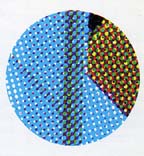
Reproducing Color Graphics

 Color
graphics are printed using the subtractive colors of Cyan, Magenta, and
Yellow. Black is added for stronger
contrast, blacker blacks, deeper shadows and for printing text and other
black solids. Theoretically, the process color system or four
color process does not need black to create the full gamut of
colors, but images are sharper with better contrast so, as long as black
is necessary for text, it is incorporated in the process. (see
“Color Systems"” for a fuller
discussion of the CMYK color space).
Color
graphics are printed using the subtractive colors of Cyan, Magenta, and
Yellow. Black is added for stronger
contrast, blacker blacks, deeper shadows and for printing text and other
black solids. Theoretically, the process color system or four
color process does not need black to create the full gamut of
colors, but images are sharper with better contrast so, as long as black
is necessary for text, it is incorporated in the process. (see
“Color Systems"” for a fuller
discussion of the CMYK color space).
 The
original graphic is scanned four times with filters which filter out all
but the black, cyan, magenta and yellow values. The screen is rotated
each time: 45 degrees for black (the standard halftone screen angle); 75
degrees for magenta, 90 degrees for yellow and 105 degrees for blue.
The
original graphic is scanned four times with filters which filter out all
but the black, cyan, magenta and yellow values. The screen is rotated
each time: 45 degrees for black (the standard halftone screen angle); 75
degrees for magenta, 90 degrees for yellow and 105 degrees for blue.
 Each
rotation produces a halftone dot. The four halftone dots represent the
shade of the color in the usual gray scale (see
"Halftones"). The four dots cannot touch or they will distort the
color values of the image, but are printed separately in a rosette
pattern. Color is usually printed with a finer screen that black and
white (see halftone screening). Where there would ordinarily be one dot
in a black and white halftone, there are four of varying sizes depending
on the color values. So, in a 200-line color image, there are
potentially 200 rosettes with four halftone dots each.
Each
rotation produces a halftone dot. The four halftone dots represent the
shade of the color in the usual gray scale (see
"Halftones"). The four dots cannot touch or they will distort the
color values of the image, but are printed separately in a rosette
pattern. Color is usually printed with a finer screen that black and
white (see halftone screening). Where there would ordinarily be one dot
in a black and white halftone, there are four of varying sizes depending
on the color values. So, in a 200-line color image, there are
potentially 200 rosettes with four halftone dots each.
Department of Communication, Seton Hall University